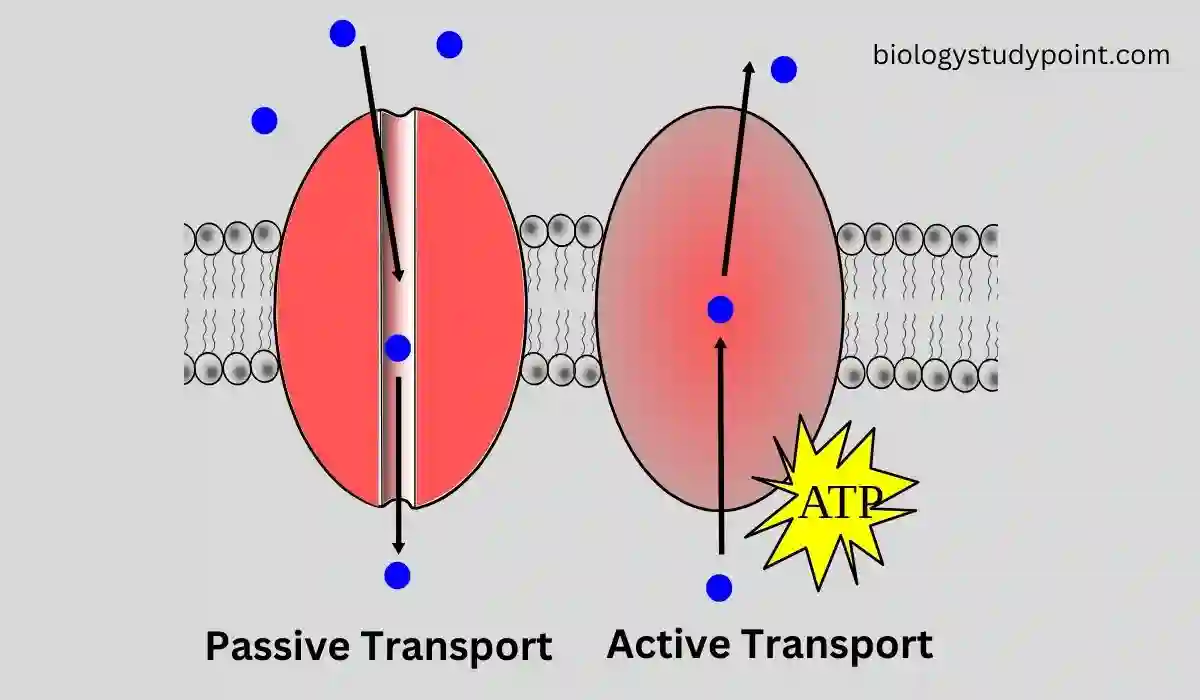Hello, guys, In today’s this article we will study about active and passive transport. Like – what is active and passive transport? What is the difference between active and passive transport? We will know the answers to many such questions today, so let’s start.
What is passive transport?
The passage of molecules of different substances through the plasma membrane from a region of high concentration to low concentration, i.e., along a concentration gradient, is known as passive transport. In passive transport, no energy is required and molecules move along the concentration gradient.
The passive transport of metabolites can be accomplished by anyone of the following Methods.
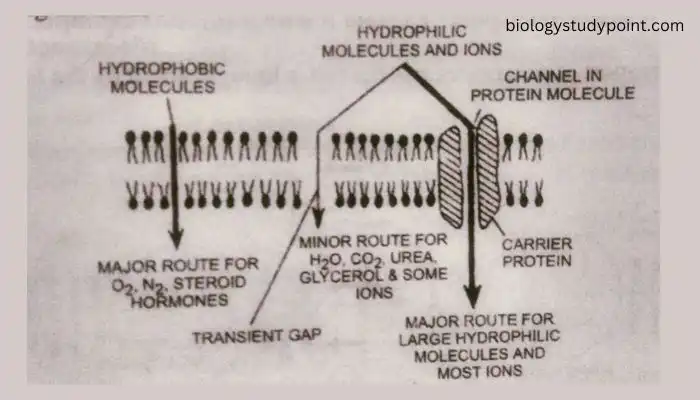
- Simple diffusion
- Facilitated diffusion
What is simple diffusion?
Transport of metabolites across the membrane along the concentration gradient and without the carrier molecule is called simple diffusion. The molecules of substances pass through the gaps or channels of membrane transport proteins, called channel proteins.
What is facilitated diffusion in biology?
In this type, diffusion of metabolites across the plasma membrane is facilitated by proteins of the plasma membrane. These proteins are called permeases. These act as carriers. The process involves following steps.
- Diffusion molecules combine with the specific carrier protein molecules, forming carrier-protein complexes.
- The shape of the carrier protein molecule changes in response to the diffusing molecule so that the membrane bound carrier protein complexes form channels.
- The shape of the carrier protein molecule changes in response to the diffusion molecule, allowing the molecule to cross the plasma membrane.
- Once the diffusing molecule has reached the other side, the change in shape of the carrier molecule (conformational change) lowers its affinity with the diffusion molecules, and allows it to be released.
- After the release of diffusing molecules, the carrier-protein molecule resumes its original shape.
The facilitated diffusion enables molecules to cross the otherwise impermeable or poorly permeable membrane.
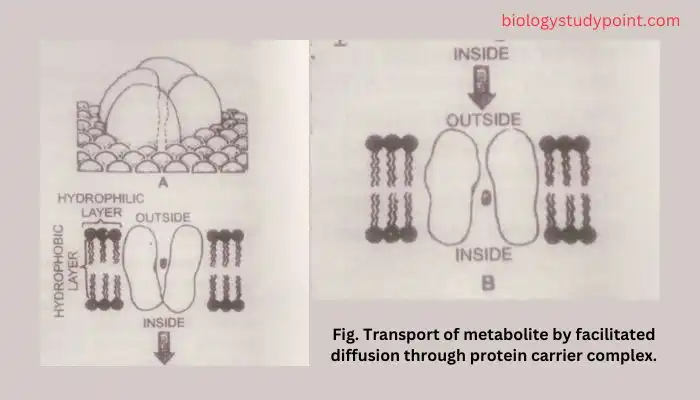
The transportation continues as long as there is a concentration gradient. It is similar to simple diffusion in that it does not require energy and takes place along the concentration gradient. But it differs from it because.
- Facilitated diffusion is (either L or D isomer is transported).
- It shows saturation kinetics.
- Facilitated diffusion requires a carrier for transport across the membrane. The carrier protein molecules move to and fro across the membrane by thermal diffusion.
What is active transport in biology?
Active Transport –
Active transport is the movement of molecules against a concentration gradient. i.e., the molecules or ions move from a region of low concentration towards a region of high concentration.
The movement of molecules can be compared with the uphill movement of water. Therefore, during active transport, energy is required. This energy is provided by ATP.
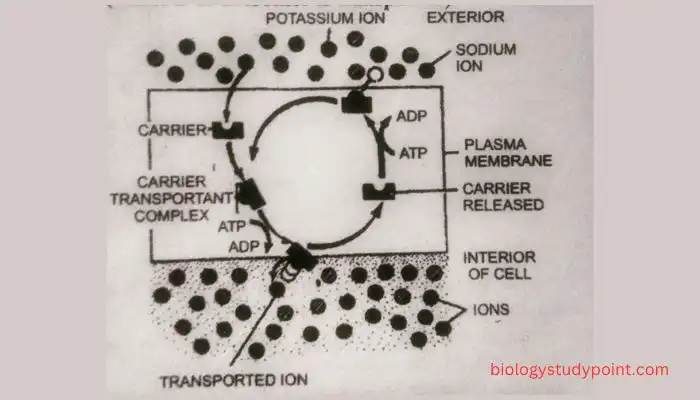
Membrane transport proteins Substances like different sugars, several metabolites, amino acids, nucleotides, and some ions like Na+, K+ and Cl- participate in active transport of substances.
Mechanism –
Carrier molecule mechanism –
It is presumed that a carrier molecule which is a protein of the plasma membrane picks up the transportation molecule (i.e., the molecule which is to be transferred) and forms a carrier-transportation complex.
For example, in the active transport of Na+ ions, Mg++ activated ATPase acts as a carrier. Its ATPase provides energy for the transport. The sodium ion is picked up from the interstitial fluid, forming a temporary complex which is carried to the opposite side of the plasma membrane and is released within the cell.
The transportant undergoes metabolic changes along with the carrier. The carrier is known as translocase or permease. Certain enzymes are found to assist in active transport.
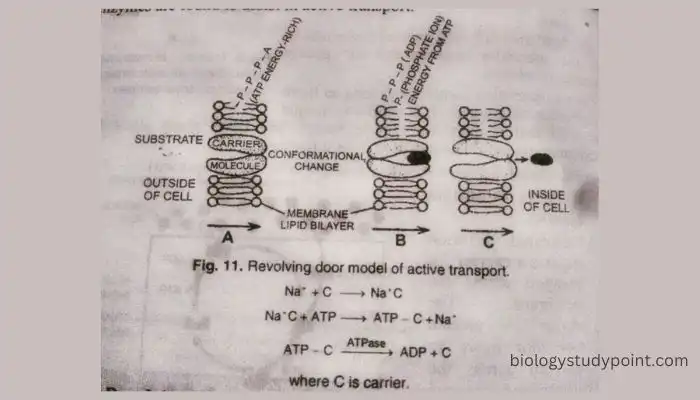
Revolving door model for active transport –
Monod and Cohen have described that during the transport of lactose across the plasma membrane in E. coli, the carrier protein has a slot facing outside. The molecule of the substance to be transported fits into this slot.
The carrier protein changes its shapes as the substance enters the slot and rotates so that the slot comes to lie on the inner side. The substance is released in the cell and the protein rotates back to its original form. The energy is spent during the process of rotation.
What is the importance of Active transport?
Active transport helps in maintaining a definite ionic concentration and definite osmotic pressure within the living system.
What is the difference between active and passive transport?
| Passive transport | Active transport |
|---|---|
| Movement of metabolites is from high to low concentration (i.e., along the concentration gradient). | Movement of metabolites is from low to high concentration (i.e., against the concentration gradient). |
| No carrier protein participates; plasma membrane remains passive. | Same. |
| No energy is spent during this process. | Energy is spent for the process and is obtained from ATP. |
Conclusion –
So friends, in today’s article we have studied what is the active transport and passive transport? And What is the difference between active and passive transport? Friends, if you like this article, then please comment, share and tell your suggestions and our mistakes.
Thank you
